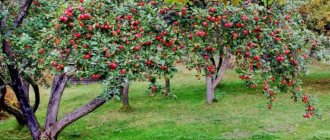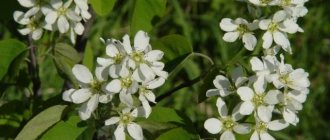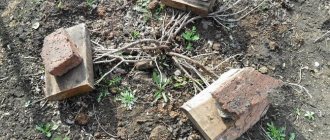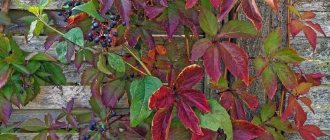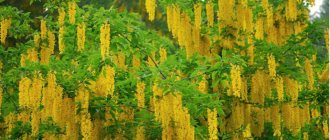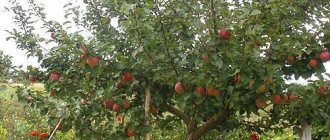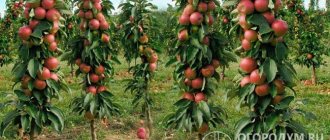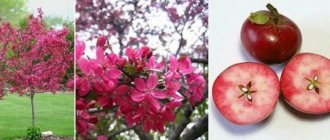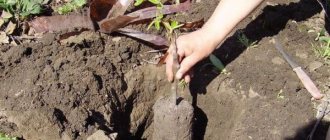Story
Grushevka is a very old apple variety, since evidence of it dates back to the times of ancient Rus'. Some researchers claim that it is more than 300 years old! Interestingly, the variety was obtained as a result of evolutionary development and natural selection.
The Moscow pear apple tree has always been valued for its resistance to low temperatures, excellent yield, juiciness and taste of the fruit. However, at present the variety has no commercial relevance, but still does not lose its attractiveness among gardeners. The first detailed description of the variety was made in 1797 in the scientific work of the famous scientist A.T. Bolotov, one of the founders of agronomy and pomology in Russia.
Popularly, the Grushovka Moskovskaya apple tree variety is also known under the name Skorospelka, which indicates an early ripening time. Another name is Spasovka, because apples are picked just in time for this holiday. Thanks to breeding work, on the basis of the Grushovka Moskovskaya variety, such varieties were created as: Grushovka Rannyaya, Grushovka Zimnyaya.
The base variety apple tree is shown in the photo below.
Features of growing Grushovka
Proper cultivation of apple seedlings requires the gardener to pay special attention to the characteristics of a particular species. You will have to take into account many different factors, climatic and weather conditions of the region, the risk of disease or pests.
Landing
Basic conditions
- It is optimal to choose the soil for the Grushovka apple tree variety: turf, sandy loam or loam, where it will thrive.
- The tree does not like areas that are overly saturated with moisture. Therefore, it is better to plant it not in hollows, but, on the contrary, on elevations, away from groundwater or open reservoirs.
- Young seedlings should not be planted in the shade, otherwise you will end up with sour, small apples. It is also worth protecting them from the wind. To do this, there should be taller trees, hedges, fences or building walls two to four meters away.
- Holes for planting are made with straight walls, up to 55-60 centimeters deep and up to 1-1.2 meters wide.
- The soil should be low acidic, up to approximately 65-67 pH. Four days before planting, about 20-25 kilograms of humus are placed in the hole.
- It is recommended that pegs that will support the seedlings at first be driven into the ground from the north side.
After planting, the trees are immediately watered, which will require approximately three large buckets of water. After this, all holes must be carefully mulched with compost or the same humus that was placed in the holes.
Disembarkation dates
The time for planting Grushovka directly depends on the growing region. The harsher the climate, the less chance a young tree has to take root. Therefore, in the northern regions it is better to plant apples in the spring, so they have a better chance of survival. The optimal time is the end of April or the beginning of May.
In the southern regions, seedlings manage to take root even when planted in autumn. At the same time, you can plant older trees from two years old. It is good to choose suitable days from mid-September to early October, long before the first frosts on the ground.
Protection from frost and rodents
This variety is not particularly sensitive, so in most cases no steps are needed to protect against cold, even for first-year plants. However, it is worth making sure that young trees do not have damage to the bark, which could affect their resistance to frost. In these places, you can apply a “bandage” of burlap or spruce branches, after covering the “wounds” with varnish.
To protect trees in winter from hungry rodents and insects that move closer to human habitation in winter, you will have to work hard. First, you need to regularly clear the garden of fallen leaves and not leave rotting fruits under the trees - all this attracts pests. The trunk must be treated with a repellent compound, for example, melted lard, grease, and then wrapped in fine mesh, burlap, roofing felt or roofing felt.
Do not forget to regularly whiten the trees in late autumn, after the leaves have completely fallen. This will save the apple trees from the development of mosses and lichens, and at the same time destroy disease spores and insect larvae.
Tree care
In order for Grushovka to please you with its high yield, you will have to make a lot of effort to provide it with appropriate care.
Watering and loosening the soil: correct agricultural technology
The variety does not like not only excessively wet soils, but also drought. In dry years, it bears fruit very sparingly, and the apples grow small. Therefore, it is recommended to regularly, approximately once or twice a month, provide abundant watering. At the end of August or beginning of September, watering is completely stopped so that the tree has time to “prepare” for winter by removing excess juices. Otherwise, it may freeze and die.
Fertilizing trees may be necessary no earlier than the second year after planting in open ground. At the very beginning, it is enough to simply loosen and water systematically. It is better to do this in the evening, when the sun has already set. For one mature tree, 40-80 liters of water is enough, and in especially dry times this amount can be doubled. Before winter, it is recommended to mulch with horse manure (a layer of up to 5 centimeters).
Crown formation: simple pruning
- Formative. A year after the trees are planted, pruning needs to be done to form the future crown. To do this, the main trunk is shortened by 35-40 centimeters, and the branches by about a third. If you wish, you can remove those that seem unnecessary to you. In the future, the formation is carried out intuitively according to need.
- Sanitary. This type of pruning of shoots should become regular. It removes damaged, dried or diseased branches.
- Rejuvenating. Typically, the age at which pear growth declines is 50, or even 60 years. Therefore, it does not hurt to perform anti-aging pruning of the crown twice or thrice during this period, which experienced gardeners more often call simply chasing. In this case, all branches are pruned to two or three year old wood.
Usually, maintenance pruning is not carried out for Grushovka, since if there is a particular abundance of fruits, the branches will still have to be supported and tied up. Therefore, there is no point in removing thinner shoots that will bring a good harvest in the future.
All pollinating trees should be within the cross-accessibility of bees at a distance of no more than 55-60 meters from each other.
Pollinator varieties
- Padding.
- Striped anise.
- Cinnamon.
- Candy.
- Bellefleur is Chinese.
- Antonovka.
- White filling.
- Crab Chinese.
Reproduction
- Growing from seeds.
- Layerings.
- Grafting (rootstock).
Diseases and pests
- Scab.
- Moniliosis.
- Black cancer.
- Wood-destroying fungi, mosses, lichens.
Grafting can be carried out on other varieties of apple trees, pear, rowan, wild apple trees or clones.
Description
Morphological characteristics and yield
The Moscow Grushovka apple tree grows quite tall and spreading, the tree trunk is erect. The height often reaches 7 m, the volume of the crown is up to 8 m. The trunk initially has the shape of a pyramid, later mature trees become spherical, formed from strong and long, drooping branches.
The shoots are painted in dark cherry shades, but with age the bark becomes yellow-orange. The tree has dense foliage, the leaves are large in the form of an ellipse, with long stems, the color is bottle green with a slight yellowish tint. The young leaves are edged, then they become smoother, with small teeth on the edges. The stipule is large and often does not fall off or falls off quite late.
Advice! Looking for a great summer apple tree? Pay attention to Moscow Grushovka and its subspecies. Before choosing, carefully study the description, characteristics of the variety, look at photos of the tree and fruit, and read reviews.
Grushovka's buds are soft pink, when they bloom the petals become almost white. Saucer-shaped flowers of small diameter (2-2.5 cm). Stamens and anthers in the amount of 10 pieces do not protrude beyond the level of the stigma.
The Moscow Grushovka apple tree lives for more than 60 years, beginning to bear fruit in 4-5 years. Productivity only increases with age. If at first it reaches 10-12 kg, then after 15 years of life the harvest volume can grow to 95-150 kg.
The frequency of fruiting is once every 2 years. Ripening dates are early, but the harvest period will extend to three weeks or more. Grushovka needs a pollinator; an apple tree of the Cinnamon variety (Antonovka, Anis, Kitayka) is suitable for these purposes.
Ripening and fruiting of Grushovka apple trees
Pear trees are planted specifically for the sake of collecting fruits, and not for decorative purposes. The timing of their ripening is directly affected by climatic conditions, as well as the weather of a particular year. Therefore, they can noticeably shift to both earlier and later periods. However, the characteristics of the variety also play an important role.
Beginning of fruiting
When the seedlings begin to bear fruit depends on the characteristics of the rootstock. Grafted onto dwarf or semi-dwarf trees will bring a good harvest already 2-5 years after planting. If Grushovka is grafted onto a wild or vigorous apple tree, rowan, or pear, then you will have to wait longer for fragrant apples - only by 6-9 years can you see fruiting.
Flowering time
Usually the apple tree blooms very profusely by the beginning of May. All trees are covered with a thick carpet of lush multi-petaled flowers. The buds have a white or pale pink color, which gradually becomes more saturated.
If you want to get a good harvest, most of the buds need to be cut off at the flowering stage (85-90%). After they turn into ovaries, it is advisable to destroy another half of the remaining amount.
Fruiting and growth
Trees of this variety very quickly begin to bear fruit abundantly. Already from the first year you can get about 8-10 kilograms of apples. However, Grushovka reaches full strength approximately 3-6 years after the first harvest.
Fruiting has an irregular basis, depending on many external factors. Therefore, it cannot be said that fruits are usually collected annually or every other year - this happens “as luck would have it.” However, if the flowering was abundant, most likely the harvest will also please you.
Top dressing
- Organic.
- Mineral.
- Complex.
What to do if it doesn’t bloom or bear fruit
- Feed with fertilizers.
- Protect from wind.
- Check for diseases or pests.
- Transplant.
- Make a trim.
Advantages
The advantages include qualities such as:
- Winter hardiness
The Moscow Grushovka apple tree is distinguished by enviable frost resistance. It is rare that a tree, especially a fruit tree, can withstand temperatures down to -45 °C. This quality helps breeders to grow new, frost-resistant varieties based on it. They exceed maternal indicators in fruit size, disease resistance, while maintaining good tolerance to low temperatures.
- Early fruit ripening
This is a very sought-after quality, because for the center and middle zone of the country there are not many varieties that provide good summer harvests. Grushovka Early, for example, begins to bear fruit in mid-July, supplying vitamins to the table for a whole month.
- Trees begin to bear fruit early
Already in the fourth year after planting, the first harvests can be obtained.
- High yield
Mature, mature apple trees can produce up to 90-160 kg from one tree.
Description of the apple tree variety Grushovka
Apples: size, color, weight
An ancient, widely known variety, which has many fans even today, is early ripening, that is, it bears fruit in the first half of autumn or summer.
Mostly they are medium in size or small, in most cases they have a pronounced onion shape. Apples are covered with thin, green or yellowish skin, which turns white as it ripens, sometimes with bright pink stripes, streaks or blush appearing on the surface. The apples have numerous whitish subcutaneous dots that are clearly visible, making the variety quite recognizable.
Many are misled by the name Grushovka, which suggests a certain taste. However, in fact, the fruits of this apple tree do not have any pear taste.
Most often, the fruits have a short and thick stalk and straw-yellowish flesh. It tastes sour, sweet-sour and even honey-sweet, mostly strongly aromatic. It may be slightly loose under the skin, but at the same time juicy and tender. The average weight is 82-120 grams. In this case, the chemical composition per 100 grams of product is characteristic:
- P-active substances – 129 milligrams.
- Vitamin C (ascorbic acid) – 9.1-9.3 milligrams.
- Total sugars (fructose) – 9.1-9.3%.
- Tetratable acids – 0.89-0.9%.
Most tasters rate the fruits at 4.3-4.6 on a 5-point scale; their taste is considered strong, harmonious, balanced and fresh.
Apple tree Grushovka: main characteristics
Crown and root system
Considered a classic apple tree, this apple tree grows as a powerful, branchy tree in the wild. Provided favorable growing conditions, it can easily reach a height of 6-7 meters. However, with proper pruning, gardeners usually try to limit themselves to 3-4 measures for ease of harvesting.
At an early age, the crown has the shape of a cone, but over the years it becomes spherical-spreading or, as people say, spreading. The tree can occupy a fairly large area up to 3-5 meters. The bark at an early age and until the end of the life cycle is yellowish-orange, in some places grayish-brown or reddish. The rhizome is often determined by the rootstock to which Grushovka is grafted, therefore it can be taprooted or taprootless, compact or highly branched.
Productivity and pollination
The Grushovka variety can be the envy of anyone in terms of productivity.
In the most fruitful years, one tree can produce from 100 to 250 kilograms of apples.
Such record harvests can only be achieved with proper care, regular fertilizing, pruning, and pest control.
If grafted onto semi-dwarf or dwarf rootstocks, the apple tree can begin to bear fruit already 3-6 years after planting. However, a wild pear tree or one grafted onto a wild one will not meet such deadlines. It will take her at least 5-8 years to reach the age of fruiting. Grushovka is considered a self-sterile variety, therefore, without the presence of other varieties nearby, no apples will be obtained. Preference should be given to those that approximately coincide in flowering time.
Winter hardiness and disease resistance
Grushovka is in demand among gardeners in our country precisely because of its special resistance to cold. A fragile but branched tree, it can easily withstand frosts down to -50°C without losing its ovaries. That’s why it is cultivated even in Siberia. Plus, a short growing season increases the chances of growing a good harvest in harsh conditions.
The main disadvantage of the variety is considered to be the extreme degree of instability to various fungal infections, in particular to the famous scab and moniliosis. Therefore, it is very important to treat with special fungicides on time. Spraying should be regular, but it should not be done for prevention; it will not have any effect.
Subspecies and rootstocks
There are several main subtypes of Grushovka, which are similar to each other, but still have some differences.
| Subspecies | Description |
| Moscow | This is a variety obtained through natural selection. It has become widespread in almost all regions, thanks to its special resistance to frost. However, it is not grown on an industrial scale, since the thin skin is very easily injured and the fruits begin to rot very quickly. It has small and medium fruits (45-85 grams). |
| Early | This subspecies is considered by scientists to be the most successful of all that appeared as a result of crossing. It was created after pollination of the common Grushka by Papyka. The fruits of the variety are much larger than those of other representatives of the variety (112-130 grams), and the yield can easily reach up to 200 kilograms from one mature tree. It is used for cultivation in the frostiest regions, although it is more common in the European part, and is most resistant to scab. |
| Winter | The subspecies was obtained through selection with the Kronselskoye Transparent variety. As a result, the fruits have become larger than those of the original variety, but do not reach the early variety (75-112 grams). |
Winter Grushovka has not become widespread, despite its fairly high yield. She can hardly tolerate cold even down to -30°C, and the scab literally “sticks” to her. The maximum where it can still be found is the middle lane.
Rootstocks: main features
Its subsequent characteristics largely depend on the rootstock on which the tree is grafted.
| Rootstocks | Peculiarities |
| Columnar | It is believed that such a rootstock makes the variety more frost-resistant. However, the fruits are usually sour and small. However, there is no official description of such options. |
| Semi-dwarf | This vaccination option is not the best solution. Experiments in this direction have shown that at 14-18 years the fusion site bursts and the tree may die. That’s why experienced gardeners don’t have such trees. |
| Dwarf | This version of the rootstock is even worse than the previous one for the same reasons. |
Most often, Grushovka is grafted onto winter and summer varieties of apple trees with good winter hardiness.
Flaws
Among the negative properties are:
- uneven ripening and poor keeping quality of fruits;
- vulnerability of trees to drought, causing fruit to drop;
- irregularity and frequency of fruiting, usually once every 2 years;
- greater susceptibility to apple scab;
- short harvest period;
- commercial disadvantage due to appearance, rapid deterioration and unsuitability for long-term transportation;
- You cannot make jam, jams, marshmallows or pickles from this variety.
How is it different from other varieties?
The Grushovka apple tree differs from other varieties primarily in its super-high winter hardiness. Few plants can tolerate frost of -50°C and are then able to produce a full harvest. The second difference is the long life cycle of the plant, which is 50–60 years, while most trees live on average 30–40 years.
Did you know? Popular singer Justin Timberlake hired an entire company to calculate the amount of carbon dioxide emitted during his concerts. As soon as the singer received the result, he immediately began planting trees in every locality where he performs to compensate for the expended amount of oxygen.
Grushovka Early
According to experts, this subtype is considered the most successful, since the apple tree has received additional useful qualities.
Description
The variety was bred in the middle of the last century, when its creator S. Isaev crossed Grushovka Moskovskaya and Papirovka (Belyi Naliv) by pollination. The fruits ripen almost 2 weeks earlier than the base variety, which explains the name Grushovka Early or Improved.
The advantages, compared to the classic Grushovka, include:
- Large and tasty fruits - weight increased almost 1.5 times;
- The pulp has a high content of vitamin C;
- Increase in yield up to 170 kg;
- Resistance to scab disease.
The tree is larger in size, has good foliage, is winter-hardy and does not reduce productivity even after very frosty winters. The apples are cream colored with light pink stripes and very juicy.
Advantages and disadvantages of "Grushovka Moskovskaya"
The advantages of the variety include the following qualities:
- precociousness;
- high productivity;
- frost resistance;
- early ripening;
- good taste of the fruit.
The disadvantages of the variety include the following features:
- frequency of fruiting;
- uneven ripening of fruits;
- poor drought resistance;
- trees are susceptible to scab;
- poor keeping quality of apples.
We invite you to familiarize yourself with Plant Growth Regulators: Types and Applications
Let us consider separately the appearance of the apple tree and the fruit.
In two years, a seedling of this variety manages to form skeletal branches. And after ten years, the plant turns into a tall tree (up to 8 meters) with a lush, wide pyramidal crown, and with age - in the shape of a ball.
An adult pear plant has a lush crown and reaches a height of 5-7 meters, which should be taken into account when planting. The bark of two-year-old seedlings is smooth and dark purple, while that of mature trees is orange-yellow.
Large elongated leaves on long petioles with a finely toothed edge are slightly pubescent on the back side and have a yellowish tint. The leaf blades of some plants are reverse folded with large stipules.
Blooming with pink buds (in May), the plant during the flowering process is covered with large white flowers, saucer-shaped, with 10 stamens and a pistil.
The fragrant fruits are slightly flattened, spherical in shape, and are distinguished by their multi-colored colors: from yellow-green to rich yellow-red, with streaks, specks and ruddy barrels on the sunny side.
The skin is thin, smooth and shiny with natural wax. The pulp is slightly yellowish, closer to the skin it is pink, loose and juicy. Overripe fruit acquires mealy fiber.
The seeds (in closed chambers) are medium in size and light brown in color. The apples are small in size (60-100 g). With good care they can reach 120 g. The taste of the fruit is pronounced sweet and sour.
Information: The pear fruit contains a significant percentage of ascorbic acid, which requires precautions to preserve tooth enamel. It is recommended to rinse your mouth thoroughly with water after eating apples.
Grushovka Winter
An apple tree of this subspecies is unfortunately not often found in gardens at present. Its creator is Professor S.F. Chernenko, who crossed the varieties Grushovka Moskovskaya and Kronselskoye Transparent.
Description
It differs from the mother variety in its later, autumn ripening period. The fruits are slightly elongated, not small. The pulp is cream-colored, juicy, sweet-sour taste. The skin color is yellow, covered with carmine stripes and specks. Productivity is good.
Winter Pear has a squat trunk, a spherical crown, and enlarged leaves. The variety is noted for its good shelf life, characteristic of autumn apples, and their taste even improves after a couple of months of storage. However, insufficient frost resistance and increased susceptibility to disease and rot reduce its commercial relevance.
Possible pests and diseases
The culture is not resistant to fungal and bacterial diseases. When bacterial diseases appear, plants cannot be treated. They are uprooted and burned.
Important! When carrying out preventive and therapeutic measures, do not forget that insecticides and fungicides of the same type can only be used throughout the year. Next season, treatment preparations should be changed, otherwise harmful microorganisms and parasites will adapt to them, which will make all measures ineffective.
The most typical fungal diseases for Grushovka are:
- Clusterosporiosis;
- moniliosis;
- fusarium;
- scab.
When they appear, the first step is to remove all infected areas. They are treated with copper sulfate and covered with garden pitch. Then spray with fungicidal agents. You can use the drug "SWITCH". Add 2 g of substance per 10 liters. The product is effective against the vast majority of fungal spores of different strains.
1 - klyasterosporiosis; 2 - moniliosis; 3 - scab. Among the pests that are dangerous for the apple tree of the variety in question are:
- aphids - you can eliminate them by spraying plants with a solution of wood ash (800 g of ash per 10 water);
- leaf roller - eliminated by dusting with tobacco dust;
- mite - treatment with a 1% solution of copper oxychloride will help to cope with it.
Landing
Selecting a location
It is very important to choose the right place for planting. The tree absolutely does not tolerate stagnation of water and high humidity, as this leads to diseases and rotting of the wood. Therefore, the main condition for good development is planting in open, sunny and elevated areas. Seedlings will take root better in mid-spring or early autumn.
The composition of the soil is also very important. Non-acidic turf, sod-podzolic, sandy loam, and light loam are suitable. On such soil the apples will be juicier and sweeter, and the tree will be pleased with its yield. Acidic soils greatly inhibit the formation of the plant and negatively affect the taste and size of the fruit.
Pit preparation and planting
The landing rules are simple:
- For good root development, the pit must be of sufficient volume, at least a meter in diameter and about 75 cm deep;
- 3 days before planting, the pit is filled with nutritious organic matter (3-4 buckets);
- The roots of the seedling are carefully distributed over a hill of soil poured in the middle;
- The earth is poured on top in several layers and each of them is slightly compacted;
- It is important to ensure that the root collar is higher than 5 cm above the soil;
- The seedling is tied to a peg driven from the north. For tying, use a soft rag so as not to damage the bark;
- Water the tree after planting - at least 3-4 buckets, then the soil is covered with mulch.
Features of planting and growing
The area for the Grushovka apple tree needs to be spacious, well lit from all sides, and at the same time protected from drafts. Plants develop best on sandy, loamy and turf soils with a neutral pH level, in the range of 5–7.5. For this variety, the main roots lie very deep, so the distance to groundwater should be at least 3 m.
When the site has been selected, you can take care of purchasing planting material. When choosing a seedling, you should first of all pay attention to its age - the younger it is, the better and faster it will take root in a new place. The most suitable option is a 1-2 year old plant.
You can determine the age of a seedling yourself:
- one-year-old plants do not have skeletal branches, and their height does not exceed 1.2 m;
- two-year-olds already have skeletal branches located at an angle of 45–90°, and the height of the trunk is 1.5 m.
Having determined the age, you need to move on to examining the trunk itself and the root system.
The stem of the plant should be smooth, without flaws or damage. The coloring throughout the trunk of a healthy specimen is uniform. The stem itself is elastic, not dry, and easily bends to the sides without making a crack. The rhizome should also be uniformly colored light gray. It is worth paying attention to the number of roots - there should be several main roots, tap roots and many additional ones. Did you know? Rings on the cut of a tree, which make it possible to determine its age, are formed only when the seasons change,
as a result of changes in the rate of development of plant tissues.
In the tropics, not a single tree has such rings, because there are no sudden temperature changes there. The underground part should not be overdried or show signs of rot. Planting can be done in late April - early May or in September - October. In any case, you need to start preparing the soil on the site in advance. It is better to start doing this six months before planting. First you need to clear the area, uproot old plants, and cultivate to a depth of 30 cm.
After this, water the soil with a 3% solution of copper sulfate. A week later, you should dig up the soil again, after adding 10 kg of sand to each m² (if the soil is sandy or sandy loam, this is not necessary), 10 kg of peat, 20 kg of fresh manure and 500 g of superphosphate.
A month before planting, cultivation must be carried out again, after adding 20 kg of compost and 800 g of wood ash to each m². 7–10 days before planting, dig a hole: hole depth 60 cm, width 100 cm. Half of the soil from the hole should be mixed with 25 kg of compost and 200 nitrophoska added. Drive a stake into the center of the hole and fill it 1/3 in layers with clean and fertilized soil. After these manipulations, pour 20 liters of warm (+30°C) water into the hole.
We recommend that you learn how to get rid of rotting apples.
Planting is carried out as follows:
- A mound is made in the center of the pit.
- Place the roots of the seedling in the hole and straighten them.
- Cover the rhizome with soil, alternating layers of fertile and clean soil.
- The trunk circle is compacted.
- Pour in 30 liters of water.
- The next day, loosen the soil around the tree and mulch it with compost.
Proper planting of an apple tree: 1 - placing the seedling in a trench; 2 - seedling buried for the winter.
Care
In order to receive good harvests in the future, in the first year of flowering, excess flowers should be cut off from the tree, leaving only 20% of their number. Then, at the ovary stage, half of it is removed. This will make the remaining fruits larger.
During the flowering and fruiting period, watering should be constant, at least two buckets weekly; during drought, this amount should be increased. At the end of summer they are stopped so that the plant prepares for the cold season.
In the first year, the soil is only loosened and sufficiently moistened. They start feeding from the second season. In the spring, humus (10 kg/sq.m.) and mineral fertilizers (urea 450 g/sq.m.) are added. In the fall, Kemira granules (35 g) are scattered around the tree trunks and dug up. You can use complex fertilizers without nitrogen. It’s a good idea to mulch the soil with humus (5-7 cm) for the winter.
Subtleties of care
In order for the tree to develop well, it will need some care. The first year of the plant’s life on the site, watering is carried out once a week, adding 20 liters at a time. From the second year, they switch to watering mode once a month, adding 40–60 liters at a time, depending on weather conditions. Watering is stopped completely 3 weeks before the expected harvest. After each watering, the soil in the tree trunk circle must be loosened, simultaneously getting rid of weeds, and then mulched.
Important! If you regularly ration the crop by removing the central fruits from the bunches at the time of ovary formation or using other methods that involve spraying with various compounds, then it is quite possible to achieve annual fruiting.
As mulch during the warm season, you can use sawdust 1:1 mixed with peat or sand. When the plant blooms for the first time, 85% of the flowers should be removed. After setting the fruits, remove half of them. If this is not done in the future, the tree will develop poorly, which will negatively affect the quality and quantity of the harvest.
From the age of two, plants begin to be fed annually according to the following scheme:
- before the buds swell - for each m², 8–12 kg of rotted manure or 400–600 g of urea (apply fertilizers into the soil to a depth of 5 cm or dilute in 30 liters of water);
- in June - add 30 g of superphosphate and potassium sulfate to 30 liters of water;
- after harvesting - 30–40 g of Kemira autumn fertilizer.
Pruning is carried out annually.
They begin manipulations the next year after planting. The central conductor is shortened by 30 cm, the side skeletal branches - by 1/3 of the length. No more than 5 skeletal branches of the first order are left on the trunk. In subsequent years, 2 branches are left on each of the skeleton conductors, the rest are cut out. Regulation of growth force and crown formation allows you to cope with the frequency of fruiting. Find out who the codling moth is.
In the future, the third tier can be formed in a similar way. When the crown is formed, sanitary pruning is performed in spring and autumn. Such manipulations involve the removal of conductors competing with the main, damaged and growing branches inside the crown. All trimming is carried out with a well-sharpened tool. After such work, all wound surfaces are treated with a 1% solution of copper sulfate or crushed activated carbon, and then sealed with garden varnish.
Apple tree pruning diagram. In autumn, the tree trunk circle is carefully loosened, the plant and soil are sprayed with Fitosporin according to the instructions. Then mulch the soil with rotted manure. The mulch layer should be at least 10 cm. After tilling the soil, the plant trunk must be whitened to a height of 1 m. For young trees (up to 3 years old), the trunk is wrapped in burlap.
Reviews
Yuri K., Ufa:
“I have been growing Grushovka for many years. It is very important that this is a summer variety. Our whole family doesn’t mind eating apples at the end of summer, these are the best vitamins. They are small in size, but have excellent taste. Children really like that they are striped and juicy. One bad thing is that the harvest doesn’t happen every year, and that they don’t last long.”
Elena I., Kaluga:
“The Grushovka Moskovskaya apple tree on our site was planted by the previous owners; it is already more than 17 years old. I read her description on the Internet, and it completely corresponds to reality. We collect the harvest in bags and even have to distribute it to relatives and neighbors. One of the features of this variety is that it is early, but the apples ripen quite small. And what’s more, they make delicious cider!”
Olga K., Moscow region:
“I love this variety for the most wonderful apples among the early ones. I’m also happy with the fact that they make excellent compotes for the winter. I add some berries to them, maybe pears or apricots, and the family is happy.”
Marina Yu., Saratov:
“The apple tree is only 8 years old, but for 3 years now it has been pleasing us with a good harvest. 4 years ago we had severe frosts, we thought that the tree would die, but it survived. I noticed that Grushovka reacts poorly to both hot weather and excessive dampness. Treatment for diseases, especially scab, is also needed.”
History of selection
Grushovka received its modern name a long time ago, even before it was described as a variety by the famous fruit tree expert A. Bolotov.
And she became a “pear tree” because the pomologist thought that the shape of her crown at an early age was similar to a ripe pear.
And the clarification - “Moskovskaya” - had to be made in order to establish the difference from the Grushovka Nemetskaya variety that existed in parallel in the West.
The improvement of the variety took place naturally, through popular efforts, occupying territories north of the Black Earth Region, in the Urals, and in developed Siberia, since apple trees were famous for their winter hardiness.
The Moscow Grushovka apple tree settled in the same latitudes of North America in the 19th century. At the exhibition in Chicago it was presented under the name Tetfsky, and in Canada, based on the pollination of its seedlings, the Mantet variety was developed, which is now popular among domestic gardeners.
Description of fruits
Grushovka apples are either small or medium. The maximum weight is 120 grams, the average is about 80. They are spherical in shape, slightly flattened, but can also be onion-shaped. The skin is quite thin and has a pleasant smell. Because the fruit has a layer of natural wax, it may appear greasy.
The pulp is juicy and friable, the color is white, but can be cream or pink. The taste is subtle, delicate, kilo-sweet or noticeably sour (if it contains a lot of vitamin C). An overripe crop has dry and mealy pulp. The calorie content of apples is 47 kilocalories per 100 grams.
It is not advisable to use the fruits for commercial purposes, since they are poorly stored and do not like transportation.
Winter hardiness
The culture is characterized by extremely high levels of winter hardiness. It can easily withstand low temperatures. Thanks to this feature, gardeners do not have to worry about the trunk freezing.
Damage to fruit buds and branches is minimal, so harsh winters with little snow will not in any way affect the quality and quantity of the future harvest.
The seedlings of this variety have similar high resistance to weather conditions in the cold season.
Resistance to diseases and pests
The tree does not have natural immunity to fungal diseases, so it can be affected by scab, which can destroy both the fruit and the apple tree itself.
Crown thinning and preventive work significantly reduce the risk of this disease. Of the insects, it most often suffers from the weevil.
Regions of growth
When choosing a climate, Moscow Grushovka is completely unpretentious: the apple tree can withstand cold and frost, is less adapted to droughts during hot summers, but with sufficient watering the growing season is not disrupted.
It can be found not only in Russia. It also found a place in Western countries, in Ukraine, Belarus, the Urals and eastern Siberia.
Origin and zoning
The description of the variety was made by the wonderful Russian scientist A.T. Bolotov, who at the turn of the 18th and 19th centuries created the world's first pomological system (pomology is the science of varieties of fruit and berry plants). “Grushovka” owes its appearance to long-term natural selection through folk selection. Thanks to the gene pool inherited from wild ancestors, the variety turned out to be very resilient and spread widely throughout Russia and neighboring countries. In 1947, it was included in the State Register of Selection Achievements.
“Bolotov's Pomology” is a scientific publication in 6 volumes with a systematic description of 661 varieties of apple and pear trees with watercolor drawings by the author depicting each fruit in life size. The work is truly fundamental (given the complete inconsistency that reigned at that time in the field of studying these cultures). It is thanks to him that Bolotov is considered the founder of scientific pomology. The author called his work: “The image and description of various breeds of apples and pears born in Dvoryaninovsky, and partly in other gardens, were drawn and described by Andrei Timofeevich Bolotov in Dvoryaninovo from 1797 to 1801.” (Dvoryaninovo is a village in the Tula province (now part of the Zaoksky district of the Tula region), in which the Bolotov family estate was located).
In terms of its winter hardiness, “Grushovka Moskovskaya” surpasses even the famous “Antonovka vulgaris” (on the left in the photo) and “Autumn Striped” / “Streifling” (on the right)
The apple tree is well adapted to various climatic conditions, including unfavorable ones, and is recommended for cultivation in the Northern regions, the Central zone, the Urals and Siberia, where it can withstand winter frosts down to −45… −50 ℃. To date, the variety has been excluded from admission to the Central Black Earth region for existing shortcomings.
Many Siberian gardeners, particularly in the Krasnoyarsk Territory, achieve good results by cultivating “Grushovka” in a creeping (stlate) form.
Apple tree Grushovka Moskovskaya: planting and caring for a summer cottage
The apple tree is a favorite fruit tree that can be found in every garden. Moreover, this is the first seedling from which planting of summer cottages begins. Ripe and aromatic fruits are used for many purposes: homemade baked goods, compotes, jam and juices. The Grushovka Moskovskaya apple tree takes pride of place; planting and caring for it is not difficult.
